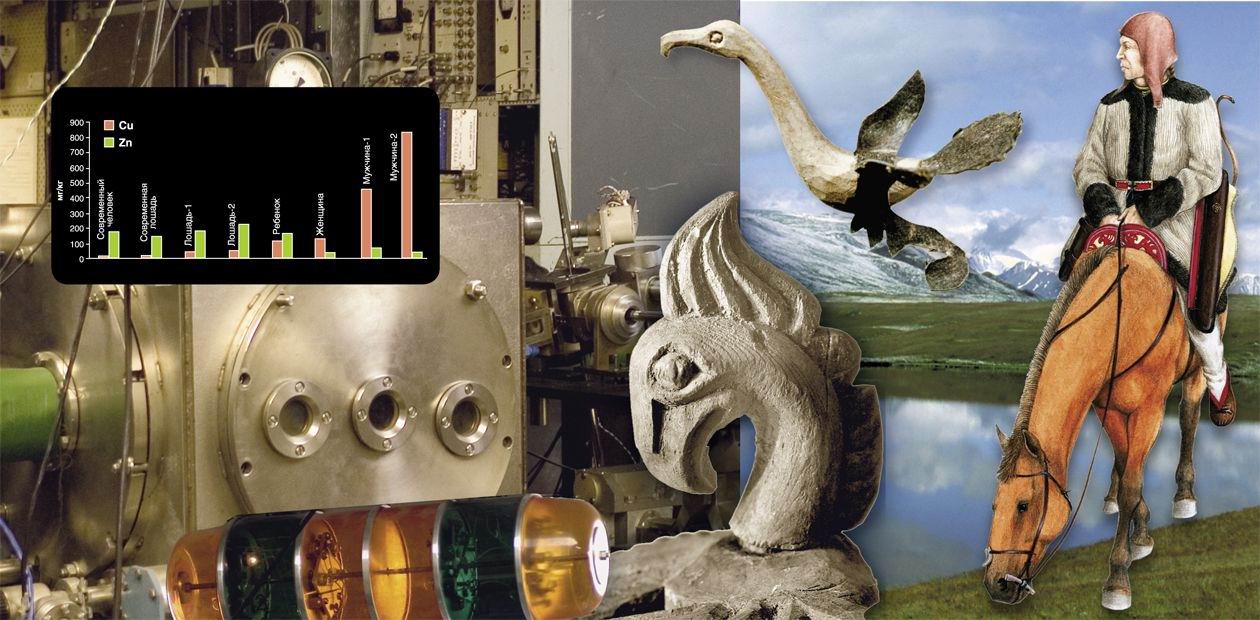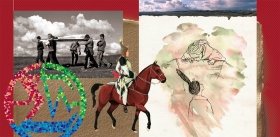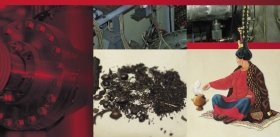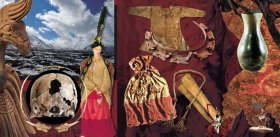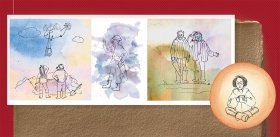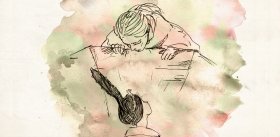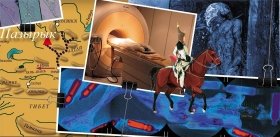Mortal Delight. SR Finds the Murderer
Archeologists of the Institute of Archeology and Ethnography SB RAS discovered “frozen” graves dating back to the end of the IV-beginning of the III century B. C. at the Ukok Plateau in the Altai Republic in the 1990s (Polosmak, 1994, 2001; Molodin, 2001). These unique sepultures refer to the Pazyryk culture, which became famous owing to the “frozen” grave phenomenon…
The essence of this phenomenon is preservation of the graves with all contents, sometimes including mummies of people and organic objects, inside thick ancient ice. This process was facilitated by both severe climatic conditions of Gorny Altai (Altai Mountains) and specific features of the burial ceremony of these ancient people (for more details, see: Polosmak, 2001). In contrast to the known “tsar” burial mounds (Rudenko, 1953, 1964), the ancient graves at the Ukok Plateau were not harassed by robbers and were discovered in an almost intact form. The well-preserved hair and nails of buried people, as well as the hair, tails, and manes of horses buried in the same grave should be noted among numerous amazing findings.
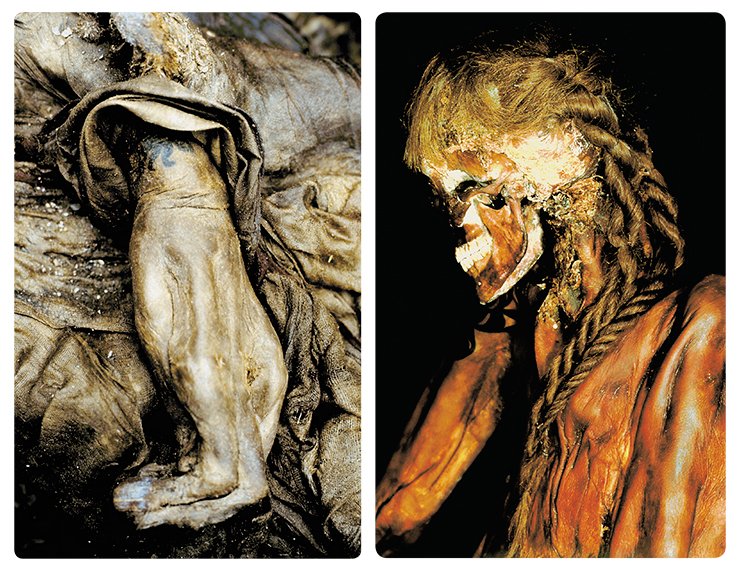
Since ancient times, people have paid special attention to hair and nails. There are numerous associated taboos and superstitious beliefs. These particles of the human body aroused a kind of mythology. In many traditional cultures, the combed-out hair and cut-off nails were collected during the whole lifetime and then put into the grave with a deceased person. The archeological research showed that the Pazyrykians from Gorny Altai also had this tradition: their graves contain cut-off locks, hair, and nails placed into small pouches. Such pouches were found for the first time by M. P. Gryaznov in the First Pazyryk Mound and by S. I. Rudenko in the Second Pazyryk Mound. Many years layer, in the Mound No. 1 of the Verkh-Kal’dzhin-2 burial ground at the Ukok Plateau, V. I. Molodin discovered a thick soft dark felt folded into a small fardel fastened by a leather lace in the grave of an ordinary man. The fardel contained accurately cut short locks of dark-blond hair, cut-off nails, hair rolled into a ball, and several wool strings.
Siberian SR center A local concentration of various research centers within SB RAS provides special conditions for basic research in versatile fields of knowledge. A unique (the only one in Russia) station of elemental X-ray fluorescence analysis on beams of synchrotron radiation (SR XRF) has been in operation for 25 years in the Siberian SR Center. A group of researchers from the Institute of Inorganic Chemistry has accumulated vast experience with various materials, including biological tissues.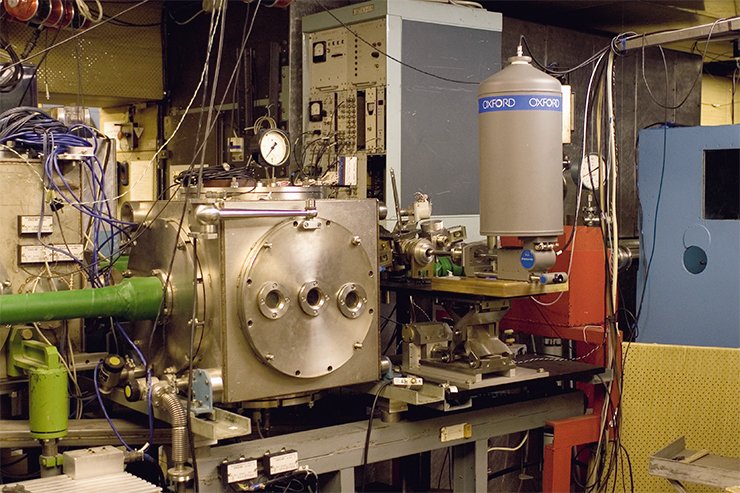
The SR XFR method allows obtaining reliable information from samples of small mass (less than 1 mg) without chemical decomposition of the sample; various chemical elements (from sulfur (S) to barium (Ba)) can be simultaneously determined in the spectrum. Methods developed for particular samples allow one to determine chemical elements with concentrations lower than 0.1 mg/kg.
Because of a combination of these factors, the method is unique. It is the SR XRF method that allows studying the microelement composition and element ratios in tissues of ancient people and animals, the sample being not destroyed during the study and remaining suitable for further research.
The hair and nails of ancient Pazyrykians were examined by the method of X-ray fluorescence with the use of synchrotron radiation (SR XRF) at the elemental analysis station in the Siberian Center of Synchrotron Radiation at the Institute of Nuclear Physics on the VEPP-3 setup. The following elements were identified: S, K, Ca, Sc, Ti, V, Cr, Mn, Fe, Co, Ni, Cu, Zn, Ga, As, Se, Br, Rb, Y, Sr, Mo, Nb, Zr, I, Sn, Sb, Ba, La, Ce, Nd, Pr, and Pb.
The most general reasons for cut-off hair and nails placed into special fardels and purses to occur in Pazyrykian graves were formulated long ago by J. G. Frazer: The idea that it is possible to cast a spell on someone with the use of his/her locks, hair, nails, or some other parts of the body is widespread throughout the world… This superstition is based on the global idea of sympathetic relation allegedly existing between a person and something that was part of his body or was in close contact with the body (1980, p. 266).
The fardels with hair and nails discovered in “tsar” mounds could belong to those people in whose graves they were found. Possibly, however, they also could be mascots or phylacteries of respected ancestors. They could also be used in malicious and harmful magic if they belonged to enemies. There is also a hypothesis that the mound could contain the dead person’s hair cut off during his first haircut in childhood.
Already during the Vedic period, the haircut (chuda-karana), which was made for three-year-old children, was a religious ceremony accompanied by singing Vedic songs and by wishing a long life, prosperity, valor, and posterity to the child. It is of interest that the cut-off hair was hidden in bull’s manure in the cow-shed, thrown into a small pond, buried in the forest, or placed onto a bunch of sacred herbs to protect the person against hostile forces. The Indians believed the manure to possess a sacred expurgatory force (Pandei, 1990). The locks from the fardel discovered in the man’s grave in the Mound No. 1 of the Verkh-Kal’dzhin-2 burial ground were also hidden in manure; the shrunk remains of manure were preserved in the fardel together with the hair.
Hair and nails — mirror of the life of ancient people
Modern science also considers the hair and nails of people as sources of important information. Measuring the isotope composition of human tissues, including hair, is an objective quantitative method for studying diets of the Paleolithic Age. The study of male hair from Mound No. 3 and female hair from Mound No. 2 of the Verkh-Kal’dzhin-2 burial ground showed that the diet of the Pazyrykians and those who lived at the Ukok Plateau afterwards included fish, which is food not quite typical for stock-breeders (O`Connel, 2001; O`Connel, Levine, Hedges, 2003). When the remains of the Russian tsars and tsarinas buried in the Kremlin became available for research, the chronicles, legends, and rumors concerning the poisoning of some of them could be checked. Thus, an analysis showed that Anastasiya, the first wife of Ivan the Terrible, was poisoned: mercury compounds were present in her hair in great amounts. The amounts of mercury compounds in the remains of Ivan the Terrible himself and his son Ivan were also more than sufficient (up to 1.3 mg), but the version about the deliberate poisoning of these persons is not supported by historical evidence; mercury could enter the organism through other ways (Panova, 2003).
Hair reflects the processes that proceed in a human body for years better than any other biological substance. The concentration of all chemical elements in hair is many times higher than that in fluids normally used for analysis: blood and urine. The content of microelements in hair reflects the microelement status of the organism as a whole, and a hair test is an integral indicator of metabolism with the participation of minerals.
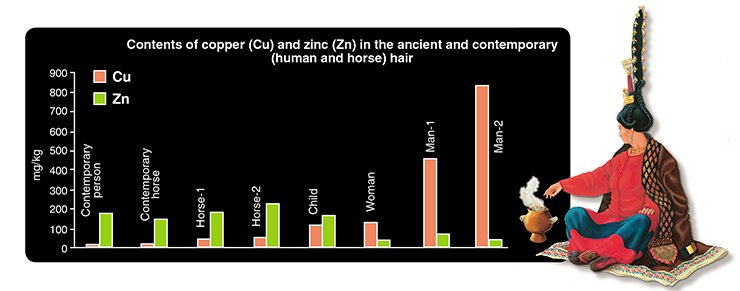
Our study was performed to determine the content of microelements in the hair and nails of the Pazyrykians who lived approximately 2.5 thousand years ago on the Ukok Plateau, to get an idea about the state of the organism at the death moment on the basis of the data obtained. The hair belonging to a man, a woman, and a child buried in Mound Nos. 1 and 2 of the Ak-Alakh-1 burial ground and to a man buried in the Kuturguntas Mound were examined.
The main attention was focused on the so-called vitally important microelements. It is clear from their names that these are microelements whose absence or lack, on the one hand, or excess, on the other hand, disturbs the normal vital functions of an organism. The role of approximately 30 chemical elements for the human body has been definitely established; without these elements, there can be no normal functioning of a human organism (Yu. N. Kukushkin, Chemical Elements in the Human Organism, 1998). The ratio of Cu and Zn turned out to be of primary interest in this study.
“Scythian Thermae” and “copper fever”
The analyzed samples of hair and nails yield information about the contents of the following elements: S, K, Ca, Sc, Ti, V, Cr, Mn, Fe, Co, Ni, Cu, Zn, Ga, Se, Br, Rb, Y, Sr, Mo, Nb, Zr, I, and Pb.
The analysis of the nails of people living at the Ukok Plateau now and those found in the Pazyryk Mound reveals the same ratios of the elements. The only difference is the elevated contents of iron and manganese in the nails of the ancient inhabitants of the Ukok Plateau. Apparently, this is related to the permanent use of water with high contents of these metals.
A comparison of the results obtained for the hair of a boy, a woman, and two men from the Ak-Alakh-1 and Kuturguntas Mounds with those for contemporary people shows that the concentrations of some elements, such as K, Ca, Ti, Cr, Mn, Fe, Cu, Sr, I, and Pb, are much higher for ancient people. The concentrations of S and Zn for Pazyrykians are lower than those of our contemporaries.
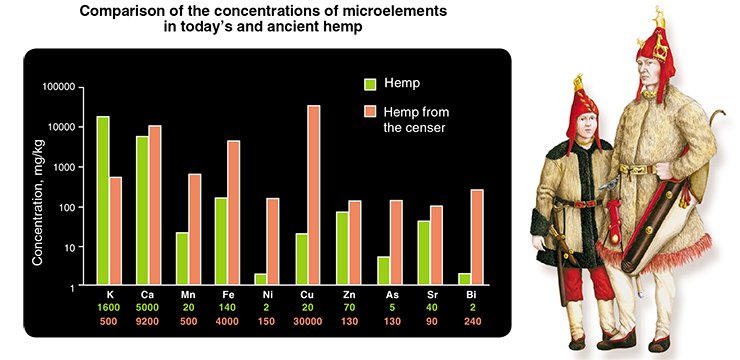
This study made it possible to consider the dynamics of the quantities that characterize the ratio of Cu and Zn in human and horse hair. These values in horse hair remain almost unchanged. In the female and male hair, the concentration of Cu was higher than the concentration of Zn by a factor of 4 and more than 20, respectively. The concentration of copper for the buried boy is close to the concentration of Zn, which indicates the beginning of distorted metabolism of these elements in the child’s organism. The high content of Cu, which caused the deficit of Zn in the microelement composition of the Pazyrykians’ hair, requires some explanation, because this obvious anomaly exerted an adverse effect on their health. This fact is indirectly evidenced by the age of the buried people: 45—50 years for the man, approximately 16 years for the woman, and approximately 8 years for the boy from Mound No. 1 of the Ak-Alakh-1 burial ground, and 30—40 years for the man from the mound of the Kuturguntas burial ground.
The antagonism between copper and zinc can play an important role in pathological processes. There are many diseases associated with the disbalance of these elements in the organism, which involves changes in the metabolism of essential fatty acids (Avtsyn et al., 1991).
How could people be poisoned by copper? The first explanation is the effect of bronze foundry. The graves contain numerous bronze and copper objects made in Altai rich in polymetallic deposits. This activity, nevertheless, could hardly have such a pronounced effect on the health of representatives of all genders and ages of the Ukok population. It is known that the Pazyrykians were mainly stock-breeders, and this specific feature of their culture is clearly reflected in their burial ceremony.
Another possible reason for gradual poisoning by copper is the permanent use of copper utensils, in everyday life. The Pazyrykians knew copper utensils, but did not use them to cook food or to drink. A small kettle on a dish with two grips and a rectangular brazier resting on four legs, which were found in the Second Pazyryk Mound (for today, these are all copper utensils found in Pazyryk Mounds), contained stones cracked under the action of fire and charry seeds of hemp; the censer grips were wrapped by birch bark, because the censer, apparently, was heated by hot stones to such a temperature that it could not be gripped by naked hands (Rudenko, 1953).
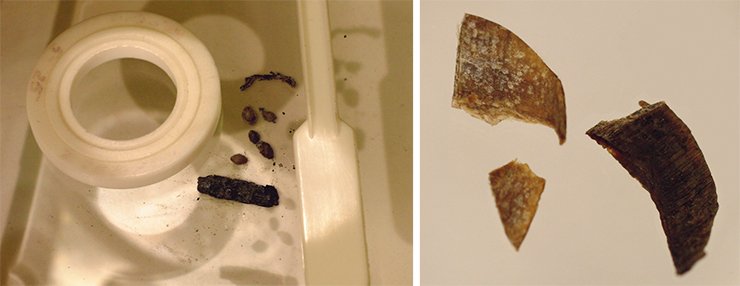
Judging by the entire set of objects discovered in the Large Pazyryk Mounds, the Pazyrykians had a ceremony of inhaling hemp aroma described by Herodotus: Scythians take hemp seeds, get under a felt yurta (nomad’s tent), and throw the seeds onto hot stones. This produces intense smoke and vapor, such that no Hellenic thermae can be compared to such a bath. Being delighted by this process, the Scythians shout loudly with pleasure (Book IV, 75). An analysis of the charry hemp seeds from the copper bowl exhibited in the Hermitage clearly indicated the accumulation of copper in these samples (the concentration of copper in them is more than three orders of magnitude greater than that in the seeds of a fresh plant). This shows that the vapor inhaled by the people did contain organometallic compounds of copper formed owing to the contact of hot stones with the inner surface of utensils, which exerted a poisonous effect on the organism. The contents of some other metals in the hemp seeds from the censer are also approximately an order of magnitude higher than their contents in the seeds of a fresh plant. This excess, however, did not involve any obvious deviations from the natural ratios of elements in the human organism.
Thus, if such hemp smoking was a Pazyrykian tradition (S. I. Rudenko believed that hemp smoking was practiced by both men and women), an excess of copper was accumulated in the organism, which was detrimental to the content of zinc. Modern studies demonstrated the consequences of such poisoning for the human health. Inhaling of copper dust or vapors of copper compounds provokes the so-called “copper fever”, which manifests itself in strong rigor, high temperature (up to 39° С), profuse sweating, and spasms of gastrocnemius muscles.
Thus, slight drug intoxication owing to the inhaling of hemp vapors was aggravated by copper-induced poisoning. The symptoms were gradually increasing. Mental disturbances, disorder in functions of the nervous system, and fever accompanied by intense sweating, high temperatures, and spasms, which were caused by the inhaling of copper vapors, enhanced the ecstatic state of people.*
*It should be noted that it is only a rather high concentration of copper compounds that is dangerous for human health. In small amounts, it has effective therapeutic propertiesThe deficit of zinc aggravated by the increasing concent-ration of copper could lead to the inhibition of growth, overexcitation of the nervous system, and rapid fatigability. Under conditions of zinc deficit, the skin is adversely affected, the mucous tunics in the mouth and gullet become swollen, and the hair becomes weak and falls out. The lack of zinc can even lead to sterility.
The results of the study suggest that events of copper poisoning were rather frequent among the Pazyrykians. The scale of this poisoning depended on whether the tradition of inhaling hemp or some other vapors from copper utensils under a felt or leather coverlet was widespread or not.
Based on the results of hair analysis, children rarely took part in the “Scythian thermae”, because the ratio of copper and zinc (about 1 mg/kg) in the boy’s hair (Mound No. 2, Ak-Alakh-1) corresponds to the beginning of copper poisoning: copper displaces zinc. The disturbance of correct relations between vitally important elements in the human organism is an indicator of the human health, and this is illustrated by the results of this study of human hair, which characterizes the conditions, way of life, and traditions of the Pazyrykians. The fact that copper poisoning is related to the cultural traditions rather than to the habitat is supported by the data on the hair of horses buried in Ak-Alakh burial grounds*. The results reveal no disturbance of the metabolism of copper and zinc in the horse organism, though the effect of the environment manifests itself in the high content of iron in the human and horse organisms; the source of iron is assumed to be drinking water.
*It should be noted that the hair-analysis results in this case could not be affected by some unknown geochemical features of the environment of the Pazyrykians who lived on the Ukok Plateau, because they did not manifest themselves earlier, when the skin of the female mummy from Mound No. 1 of the Ak-Alakh-3 burial ground was scanned for some other purposes and the element composition of the substance of her wig was determined (Malakhov et al., 2001)An analysis of the hair showed that the Pazyrykians had higher contents of many microelements than contemporary people. In our work, we tried to demonstrate that the reason for metabolism disturbances that could lead to the lethal outcome was a significant increase in the copper content and, hence, a decrease in the zinc content, which was a consequence of the inhaling of hemp vapors from copper utensils — a common Pazyryk tradition. Other dis-crepancies between the microelement composition of the hair of contemporary people and the Pazyrykians who lived more than two thousand years ago in mountainous valleys of Altai are still to be explained. The following question arises: Can the contents of some elements in the hair of ancient people who supposedly lived on an ecologically pure planet be a reference for modern researchers? Or should the reference point be the hair of contemporary people whose microelement composition reflects all “achievements” of post-industrial civilization? V. I. Vernadskii wrote: Indeed, none of the living organisms is in the free state on the Earth. All organisms are inseparably and continuously linked (first of all, via food and breathing) with the surrounding material and energy medium. They cannot exist outside the natural environment (2001, p. 339). Possibly, the analysis of the microelement composition of the ancient hair will allow the researchers to determine not only the pathologies, but also the concentrations and ratios of microelements in the organism that are more consistent with the concept of a “healthy person.”
References
Avtsyn A.P., Zhavoronkov A.A., Rish M.A., Strochkova L.S. Human Microelements, Meditsina, Moscow, 1991, 496 pp.
Antonovich E.A., Podrushnyak A.E., Shchutskaya T.A. Toxicity of copper and its compounds, in: Advanced Problems of Toxicology (Collected Papers) Kiev, 1999, No. 3.
Harmful Substances in Industry, Khimiya, Leningrad, 1977, Vol. 3, pp. 330—336.
Malakhov V.V., Vlasov A.A., Ovsyannikova I.A., Plyasova L.M., Kraevskaya I.L., Tsybulya S.V., Stepanov V.G. Material composition of findings in “frozen” graves of the Pazyryc culture, in: Phenomenon of Altai Mummies, UIAE SB RAS, Novosibirsk, 2001, pp. 162 — 170.
Molodin V.I. Cultural and historical characteristic of the burial complex of Mound No. 3 of the Verkh-Kal’dzhin-2 burial ground, in: Phenomenon of Altai Mummies, UIAE SB RAS, Novosibirsk, 2001, pp. 86—119.
Panova T.D. Kremlin Burial-Vaults. History, Fate, and Mystery, Indrik, Moscow, 2003, 223 pp.
Polosmak N.V. Gold-Guarding Griffins, Nauka, Novosibirsk, 1994, 122 pp.
Polosmak N.V. Ukok Riders, INFOLIO-PRESS, Novosibirsk, 2001, 335 pp.
Rudenko S.I. Culture of Gorny Altai Population in the Scythian Times, Izd. Akad. Nauk SSSR, Moscow, Leningrad, 1953, 387 pp.
Trounova V.A., Zolotarev K.V., Baryshev V.B., Phedorin M.A. Analytical possibilities of SRXRF station at VEPP-3 SR source, Nuclear Instruments and Methods, 1998, Vol. A405, pp. 532—536.
Spyrou N.M., Okanle O.A., Adans L.L., Beasley D., Butler C., Altaf W. Book of Abstracts, 7th International Conference on Nuclear Analytical Methods in the Life Sciences (Antalya, 16 — 21 June 2002), 2002, p. 217
The authors are grateful to L. L. Barkova for the hemp samples from the State Hermitage Collection granted for the analysis.
The Editorial Board is grateful to M.V. Shun’kov and S. I. Zelenskii (United Institute of Automation and Electrometry (UIAE) SB RAS) for their assistance in photographing the samples of nails and hemp


